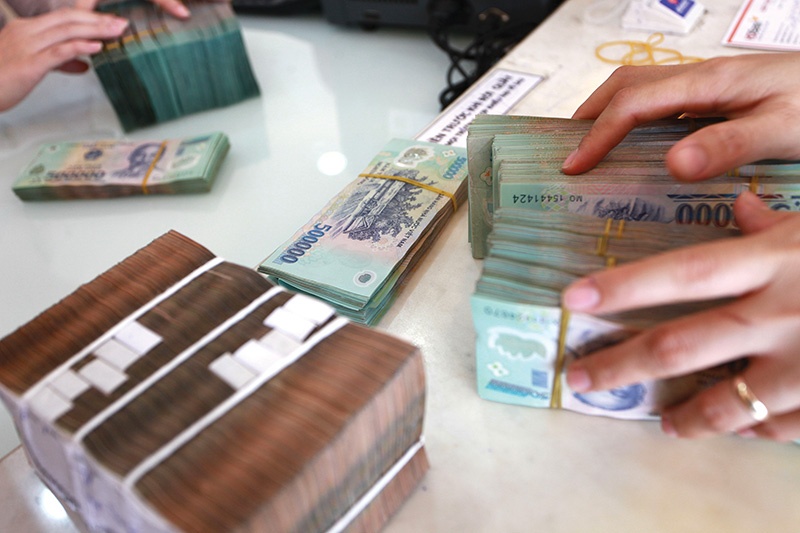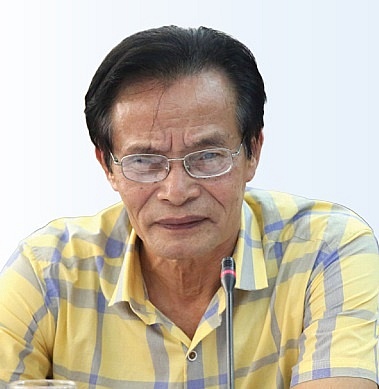Resolution upgrade sought to craft transparent debt market
 |
| Changes made for bad debt settlement in 2017 need to be extended as the issues of the last 18 months have moved plans off-course. Photo: Le Toan |
According to the State Bank of Vietnam (SBV), bad debt and the identification of prospective debt as bad debt have climbed dramatically since the beginning of the year, bringing the entire system back to the level seen in 2016 and 2017.
Le Trung Kien, representative of the Inspection and Supervision Agency at the SBV said that the introduction of Resolution No.42/2017/QH14 on piloting the bad debt settlement of credit institutions in 2017 has brought numerous outcomes in banks’ restructuring plans, linked with bad debt settlement across 2016-2020.
Non-performing loans (NPL) fell from 1.99 per cent at the end of 2017 to 1.91 per cent in 2018, and then to 1.63 per cent in 2019. However, by 2020 the figure had risen to 1.69 per cent, and by the end of September, it rose to 1.9 per cent. In short, Kien said, the current figure is as high as before Resolution 42 was introduced. “Needless to say, we can feel the brunt of how devastating the pandemic’s impact on credit institutions has been,” he added.
In Q3, many localities had to enforce protracted social isolation, thus manufacturing and commercial operations and supply networks were disrupted, which in turn impeded banks’ performance.
Nguyen Quoc Hung, general secretary at the Vietnam Banks Association (VBA), stated companies continue to encounter several challenges in both combating the disease and maintaining their production. On average, 10,000 companies had to halt or close their businesses, including banks’ clients. Consequently, this could put the banking industry in jeopardy, and NPLs may rise in the near future.
On the other hand, credit institutions are seeking to extend the period of Resolution 42 on debt settlement and the necessity to adopt this regulation because existing loans have not yet been addressed and new NPLs are under increasing pressure.
Tran Phuong, chairman of the Policy Committee at the VBA and a representative of BIDV, also stated that Resolution 42 still has numerous issues regarding the right to seize security assets and the application of simplified processes, paperwork, and payment priority, among others.
Phuong also proposed that state agencies expedite the process of removing obstacles related to the mechanism while also working closely with credit institutions to solve debt settlement operations, enhance online activities, and avoid stagnation when receiving dossiers for settlement, as well as promote a transparent debt market.
Vietnam Asset Management Company (VAMC) in mid-October officially established the country’s first debt exchange platform to pave the groundwork for larger-scale legal trading of distressed assets.
Katia D’Hulster, lead financial specialist, and Ruth Neyens, senior consultant at the World Bank, emphasised that a fully functioning NPL market together with an electronic debt trading platform is required to facilitate the disposition of the large volume of distressed assets held by the VAMC and the banks.
“The development of an NPL market is complex, multifaceted, and goes far beyond just creating a legal and regulatory framework to support NPL transactions,” they wrote. “Successful NPL market development requires a more coordinated and consultative approach amongst numerous stakeholders within the government, the broader financial community and, other private sector participants, both domestic and foreign. This approach provides a unique opportunity to build a market that considers the needs of all its participants.”
Many banks have ramped up their presence in other non-credit services to improve their net interest margin owing to higher interest rates than traditional lending.
Banks are vying with each other on mobilising current account saving accounts (CASA) to assist lower capital expenses, which will be a prevalent trend.
“Furthermore, the sustained decline in deposit interest rates will assist banks in lowering capital expenses in 2021 and 2022. Some banks with a high CASA ratio (Techcombank, MB, Vietcombank, and MSB) are expected to gain an upper hand. A ratio greater than 30 per cent enables these banks to have low capital expenses, thus enhancing their efficiency,” noted BIDV Securities Company (BSC).
Besides this, lending growth of 13 per cent this year has been aided by banks’ easing of credit objectives in Q4. Many banks were given extra credit objectives if the credit cap was attained within the first nine months of the year.
Accordingly, TPBank has been allocated the largest credit growth for the development of 23.4 per cent for the entire year of 2021.
Following that, Techcombank, MSB, and MB grew by 22.1, 22, and 21 per cent, respectively, illustrating a more pliant quota to pursue their expansion objectives.
BSC also updated its forecast for the entire banking industry’s revenues and profits in 2021 to $17.7 billion, up 16.7 per cent on-year and $7.1 billion, up 24.2 per cent, respectively. This growth rate remains unprecedented in comparison to 2020.
BSC further stated that the reduced profit forecasts are mostly attributable to the provisioning for debt rescheduling circular in H2/2021, as well as the anticipated modest drop in asset quality owing to the pandemic.
| Nguyen Tu Anh - Director General Economic Affairs, Central Party’s Economic Commission
High inflation is not a positive sign for the economy, but super-low inflation while lending interest rates remain relatively high in comparison to other regional economies in the area is also detrimental to the domestic economy. The inflation rate in Vietnam has been consistently low over the years, indicating that the economy’s demand is less than it should be. To keep inflation low and stable, the government often sets us an inflation target of around 4 per cent. However, Vietnam should not set an annual inflation goal lower than 4 per cent, but rather calculate it based on inflation in a bid to avoid the rigidity of the central bank’s inflation targeting policy and to capitalise on various prospects for economic recovery. For example, the average figure during the period of 2021-2025 should be calculated as a whole, which is less than 4 per cent. This gives the SBV greater choices for implementing monetary policy. If inflation in 2021 is too low, falling short of 4 per cent, it is acceptable to tolerate inflation exceeding 4 per cent in 2022. With this attitude, the market’s confidence in the SBV’s commitment to managing inflation will not be shaken. On the contrary, with more flexibility, the SBV will have more grounds to control inflation. Most importantly, we must not let the threat of inflation deter us from taking decisive actions to recover and breakthrough in the new post-pandemic era. | |
| Nguyen Tuan Anh - Head of Credit Department, State Bank of Vietnam
To assist vulnerable customers, the SBV reduced interest rates thrice, offering liquidity and favourable circumstances for credit institutions to lower lending interest rates. The central bank has also directed banks to cut operational expenses and utilise financial resources to lower lending interest rates to assist clients in need. Regarding credit management, based on the National Assembly and the government’s economic growth and inflation targets, the SBV set oriented credit growth targets for the entire year, with adjustments in line with current developments. The central bank regularly reviews, modifies and adjusts credit growth targets for each credit institution based on their situation, financial capacity, management, and stability of credit expansion. As a result, credit institutions that lower lending interest rates to support affected clients will be given priority consideration. Specifically, the SBV has chosen to refinance SeABank, MSB, and SHB, with a package totalling $173 million for banks to lend to Vietnam Airlines, the national flag carrier which is particularly vulnerable due to the pandemic. | |
| Andrew Jeffries - Country director, Asian Development Bank
Non-performing loans received impetus from the legal reform in 2017 through Resolution 42 that facilitated the disposal of collateral and the restructuring of bad assets. The resolution has given VAMC and banks additional powers, including the ability to acquire NPLs at market value rather than face value, which had previously constrained its ability to sell without incurring losses. Resolution 42 has facilitated the seizure of collateral in the event of a borrower default and the sale of bad debts at market value to a broader set of market participants, ensuring a quicker resolution of legacy problem assets. It also accommodated fast track court procedures and coordinated efforts for accelerated disposal of NPLs and associated collateral. Banks’ implementation of temporary credit relief measures allows forbearance towards clients in difficulty. Given the legacy problem assets and risks of rising defaulted debts due to the impacts of the pandemic, it is critical to ensure the effective implementation of the resolution, but currently it is only valid until August 2022. An NPL resolution is subject to several laws and regulations. For an effective resolution, it is good timing to make a thorough assessment of the effectiveness of Resolution 42 as the basis for making further improvements or upgrading to an overarching law on NPLs to provide a comprehensive legal framework for NPL resolution. VAMC’s capital base and capacity are expected to be further improved to help accelerate the disposal of NPLs. It is also recommended to develop an active debt trading market, and further, encourage coordinated efforts among concerned agencies and stakeholders for ensuring the effectiveness and efficiency of NPL resolution. | |
| Le Xuan Nghia - Economist
The biggest difficulties next year may stem from the probability that the SBV may prolong the debt rescheduling through the end of 2022 rather than the original deadline of June, as the existing norms require. If this happens, it will add more pressure on the banking sector, particularly those who lend large corporations, because most of these corporations have negative cash flows, except for funds backed by stock market growth. The stock market expansion, notwithstanding, is difficult to predict, and no-one may guarantee if this uptrend is sustainable or not in 2022. Furthermore, inflation is a major danger to the market, as inflationary tension is exerting hardships on all economies. Moreover, macroeconomic restrictions such as cost-push inflation and exchange rate fluctuations, government bond yields, and interest rates, may have an impact on the banks’ general business as well as the capital business. In the current context, the government should seek another strategy to limit banks’ participation in economic stimulus programmes, such as lowering fees and interest rates as well as deferring debt, which causes numerous challenges for banks. There are various approaches to enhance the economy’s health, such as fiscal and monetary policy. Furthermore, the government could launch guarantee programmes to support bank lending to large corporations. This is crucial to avoid a sharp contraction in banks’ credit. These are steps that Japan, the EU, and the US have implemented. |
What the stars mean:
★ Poor ★ ★ Promising ★★★ Good ★★★★ Very good ★★★★★ Exceptional
 Tag:
Tag:
Related Contents
Latest News
More News
- PM orders investment model for North–South high-speed rail (December 22, 2025 | 17:43)
- First members of Danang International Finance Centre revealed (December 22, 2025 | 17:39)
- Securing capital and efficiency for Vietnam’s 2026-2030 growth ambitions (December 17, 2025 | 10:00)
- Driving double-digit growth through green and circular transformation in Vietnam (December 17, 2025 | 09:00)
- Vietnam bucking trend in the global M&A landscape (December 16, 2025 | 14:20)
- Vietnam’s green transition demands collective financial action (December 15, 2025 | 12:00)
- VIR workshop highlights capital and policy for sustainable development (December 15, 2025 | 11:00)
- National Assembly approves pilot mechanisms to accelerate major projects in Hanoi (December 12, 2025 | 11:29)
- Vietnam eases policy approval requirements, simplifies foreign and outbound investments (December 11, 2025 | 17:53)
- Unpacking new momentum in Vietnam’s M&A market (December 10, 2025 | 09:59)


























 Mobile Version
Mobile Version